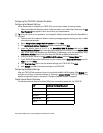Page 70 SonicWALL Internet Security Appliance Administrator’s Guide
Chat Scripts
Some legacy servers can require company-specific chat scripts for logging onto the dial-up servers.
A chat script, like other types of scripts, automates the act of typing commands using a keyboard. It
consists of commands and responses, made up of groups of expect-response pairs as well as
additional control commands, used by the chat script interpreter on the TELE3 SP. The TELE3 SP
uses a default chat script that works with most ISPs, but your ISP may require a chat script with
specific commands to “chat” with their server. If an ISP requires a specific chat script, it is typically
provided to you with your dial-up access information. The default chat script for the TELE3 SP has
the following commands:
ABORT ‘NO DIALTONE’
ABORT ‘BUSY’
ABOR ‘NO CARRIER’
“ATQ0
“ATE0
“ATM1
“ATL0
“ATV1
OK ATDT\T
CONNECT \D \C
The first three commands direct the chat script interpreter to abort if any of the strings “NO
CARRIER”. “NO DIALTONE”, or “BUSY” are received from the modem.
The next five commands are AT commands that tell the chat interpreter to wait for nothing as
“ defines an empty string, and configure the following on the modem: return command responses,
don’t echo characters, report the connecting baud rate when connected, and return verbose
responses.
The next line has OK as the expected string, and the interpreters waits for OK to be returned in
response to the previous command, ATV1, before continuing the script. If OK is not returned within
the default time period of 50 seconds, the chat interpreter aborts the script and the connection fails.
If OK is received, the prefix and phone number of the selected dial-up account is dialed. The \T
command is replaced by chat script interpreter with the prefix and phone number of the dial-up
account.
In the last line of the script, Connect is the expected response from the remote modem. If the
modems successfully connect, Connect is returned from the TELE3 SP modem.The \D adds a pause
of one second to allow the server to start the PPP authentication. The \C command ends the chat
script end without sending a carriage return to the modem. The TELE3 SP then attempts to establish
a PPP (Point-to-Point Protocol) connection over the serial link. The PPP connection usually includes
authentication of the user by using PAP (Password Authentication Protocol) or CHAP (Challenge
Handshake Authentication Protocol) from the PPP suite. Once a PPP connection is established, it
looks like any other network interface.


















